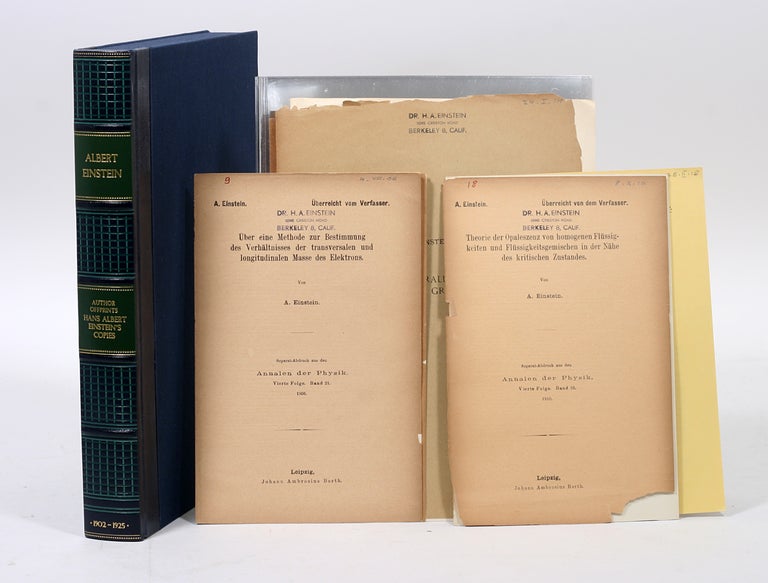Author offprints (13), from the library of Hans Albert Einstein
UNLESS OTHERWISE INDICATED, ALL OFFPRINTS ARE IN FINE CONDITION AND IN THEIR ORIGINAL PRESENTATION WRAPPERS, WITH THE OWNERSHIP STAMP OF HANS ALBERT EINSTEIN ON THEIR FRONT COVER. MOST HAVE SOME MANNER OF BRIEF HANDWRITTEN NUMERIC INDEXING AND DATING ON THEIR COVER, VERY POSSIBLY IN THE HAND OF HANS ALBERT.
Kinetische Theorie des Warmegleichgewichtes und des zweiten Haupsatzes der Thermodynamik. Annalen der Physik 9, 1902. STATISTICAL MECHANICS -- a pioneering use of strictly statistical methods in thermodynamics; applied to the general theory of heat (with especial attention to the concept and definition of temperature, entropy, and thermal equilibrium), Einstein’s work significantly refined the existing classical theory. Some historians of science view this paper as Einstein’s first step toward a “general theory of statistical thermodynamics,” insofar as the statistical approach first utilized here is the methodological foundation of his Nobel Prize winning work on the photon, his work on Brownian motion, and many papers on thermodynamics and quantum theory. Some very slight chipping to wrapper edges. (Weil 3).
Uber eine Methode zur Bestimmung des Verhaltnisses der transversalen und longitudinalen Masse des Elektrons. Annalen der Physik, 21, 1906. A method for empirically verifying THE EQUIVALENCE OF ENERGY AND MASS: Einstein presents an experimental apparatus enabling the accurate quantitative determination of the change in the electron’s mass at different velocities. (Weil 14).
Uber die im elektromagnetischen Felde auf ruhende Korper ausgeubten ponderomotorischen Krafte. Annalen der Physik 26, 1908. SPECIAL RELATIVITY. Co-authored with J Laub, this paper derives the relativistic formula for the ponderomotive force of magnetizable bodies (on the basis of electron theory) – superseding Lorentz’s classical electrodynamic force law. (Weil 23).
Theorie der Opalesenze von homogenen Flussigkeiten und Flussigkeitsgemischen in der Nahe des kritischen Zustandes. Annalen der Physik, 33, 1910. WHY THE SKY IS BLUE. Basing himself in the kinetic theory of heat, Einstein here gives quantitative details concerning the opalescence generated by the strong density fluctuations of a fluid near the critical state of condensation or of two fluids near critical state of mixture. Front wrapper chipped at lower right (approx. 1.5” x .75”; not affecting text) and split through along joint. (Weil 36).
Berichtigung zu meiner Arbeit: “Eine neue Bestimmung der Molekuldimensionen”. Annalen der Physik, 34, 1911. Einstein’s correction to his Dissertation (published 1905) in which he established a measure for the real size of molecules. (Weil 41).
Lichtgeschwindigkeit und Statik des Gravitationsfeldes. Annalen der Physik 38, 1912. [OFFERED WITH] Zur Theorie des statischen Gravitationsfeldes. Annalen der Physik 38, 1912. FIRST STEPS TOWARD GENERAL RELATIVITY-- two related and sequential papers from Einstein’s “Prague years” concentrating on gravity’s influence on electromagnetic and thermodynamic processes and deriving the equality of inertial and gravitational mass. Einstein here firmly concludes that the framework of Special Relativity is insufficient for achieving a theory accommodating light in a gravitational field, and then further proposes a nonlinear field equation for gravitation to replace the Poisson equation of Newtonian gravity. These papers are based on Einstein’s insights that 1) changing the description of a system from an inertial to non-inertial reference frame is equivalent to adding a special gravitational field, and 2) the local (variable) velocity of light is to be identified with gravitational potential. Small bend to lower corner of one rear wrapper (and last pages of offprint). Two offprints offered together. (Weil 47).
Prinzipielles zur Verallgemeinerten Relativitatstheorie und Gravitationstheorie. Physikalischen Zeitschrift, XV, 1914. Responding to Mie’s criticism of his 1913 Entwurf article (a criticism which insisted that gravity had to be incorporated within the framework of Special Relativity), Einstein here asserts the field equations of gravitation cannot be formulated in generally covariant form. Some chipping at top edge and upper fore-edge of front wrapper. (Weil 64).
Die formale Grundlage der allgemeinen Relativitatstheorie. Sitzungsberichte der Koniglich Preussichen Akademie der Wissenschaften, XLI, 1914. GENERAL RELATIVITY. On the general mathematical principle of the Absolute Calculus and tensor calculus; Einstein here rewrites the Maxwell-Lorentz equations of electromagnetism in generally covariant form. (Weil 68).
Ein einfaches Experiment zum Nachweis der Amperschen Molekularstrome. Verlandungen der Deutschen physikalischen Gesellschaft, XVII, 1916. Einstein proposes a new and further experiment to confirm the findings of THE EINSTEIN-DE HAAS EXPERIMENT (which validated Ampere’s hypothesis that magnetism is caused by the microscopic circulating motions of electric charges – ultimately leading to the detection of electron spin). (Weil 82).
Theoretische Bemerkungen zur Supraleitung der Metalle. Gedenboek Kammerlingh Omnes, 1922. On the superconductivity of metals, a topic in which Einstein had a sustained interest – Einstein here discussing the model of electric conductivity implied by the Drude electron theory of metals. A rare publication in any form. (Weil 128).
Zur affinen Feldtheorie. Sitzungsberichte der Preussichen Akademie der Wissenschaften, XVII, 1923. Einstein’s first significant effort toward UNIFIED FIELD THEORY. Drawing inspiration from the ideas of Weyl and more significantly Eddington, Einstein here presents a pure affine formulation of gravitation which only subsequently introduces a metric tensor; this paper marks Einstein’s first use of distant parallelism, a concept he repeatedly employed in later efforts at unified field theory. A True Author Offprint (Uberreicht vom Verfasser), not to be confused with the more common “trade” format. (Weil 132).
Zur Quantentheorie des idealen Gases. Sitzungsberichte der Preussichen Akademie der Wissenschaften, 1925. BOSE-EINSTEIN CONDENSATE. Complement to Einstein’s statistical analysis of ideal gases and its consequent implied Bose-Einstein condensate (W*142 & W*144), this paper “attempts to extend and exhaust the characterization of the monatomic ideal gases without appealing to combinatorics.” Einstein here tries to avoid the condensate phenomenon implied in the prior papers, and accordingly takes an approach that is closer to a thermodynamic analysis. The arguments here are “based on Einstein’s belief in the complete analogy between the thermodynamics of light quanta and of material particles and invoke consideration of adiabatic transformation as well as of dimensional analysis.” This offprint has a double set of presentation wrappers. (Weil 145).
Check Availability:
P: 212.326.8907
E: michael@manhattanrarebooks.com

